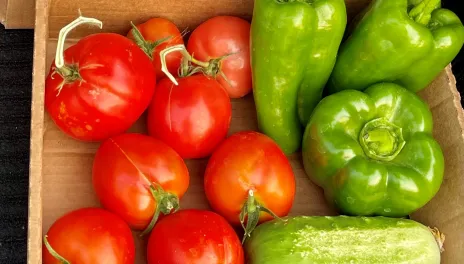When and How to Plant Vegetables
Good day! I hope all is well!
The average rainfall for the county in the past week was 2.5 inches. The high temperature for the past week ranged from 58 to 70 degrees Fahrenheit with an average of 65 degrees Fahrenheit. That average is warmer than last week, but still three degrees Fahrenheit below the average of 68 degrees Fahrenheit we should be having. The temperature forecast for the coming week will be very much below normal and slightly below normal.
Backyard poultry producers please keep practicing biosecurity, even though the Highly Pathogenic Avian Influenza (HPAI) has not increased in commercial or backyard flocks or in wild birds this past week.
There are four major time periods to plant vegetables, late-April, early-May, late-May and mid-summer. Within each of these time periods there can be a large time frame to plant vegetables.
Late-April vegetables which could have been planted by now, if the soil conditions would have been fit, but still can be planted till the end of May, with a few exceptions. Late-April species include radishes, Swiss chard, asparagus, lettuce, broccoli, cauliflower, Brussel sprouts, red beets, carrots, onions, green onions, parsnip, cabbage, collards, mustard greens, turnip, rutabaga, kohlrabi, endive, kale, and celery. These species can be planted starting in the end of April or maybe sooner if you are willing to cover them when the temperature gets below 25 degrees F. Species that should not be planted any longer include radishes because they can become bitter with hot temperatures and spinach because it will quickly produce a stem (process called bolting) now that the daylength is getting longer. It is best to transplant plants of Brussel sprouts, cabbage, cauliflower, asparagus, and broccoli at this time of the year rather than starting these species by seeds.
Early-May vegetables include potatoes, peas, sweet corn, and popcorn. For potatoes temperatures of 32 degrees F will kill any exposed plant tissues, but the plant will not be dead, unless the temperature gets below 25 degrees F. Peas can handle temperatures down to about 27 degrees F, but corn will freeze off around 30 degrees F, but will not be dead, unless temperatures get below about 22 degrees F. Potatoes and sweet corn can be planted into mid-June depending upon the maturity of these species. It is probably not best to plant peas and popcorn after June 1st because peas don’t like hot temperatures and popcorn has a long growing period.
Late-May vegetables should not be planted until after May 24th which is the last spring frost, although last year it was 31 degrees F on May 28th! Late-May species include beans (lima, green, and dry), cucumbers, muskmelon, watermelon, pumpkin, squash, tomato, pepper, okra, and eggplant. I would suggest not planting some of the vine crops after June 15th because the growing season will not be long enough.
Mid-summer vegetables include cabbage, broccoli, turnips, carrots, red beets, lettuce, green onions, radishes, peas, spinach, and kohlirabi. Cabbage and broccoli should be transplanted around July 20th along with planting peas. The other species could be planted at that time or into early August. Radishes take about 28 days to harvest, so maybe plant them about mid-August so it will not be so hot.
Depth to placing the seeds is critical to planting success. Also be sure you have good soil to seed contact. Plant most species to a depth of twice the diameter of the seed. Corn should be planted at least 1.5 inches deep, but 2 inches is preferred. This is for proper root development and standability. Lettuce should only have a dusting of soil covering the seed, meaning no more than 1/16 of an inch. Transplant plants to the depth at which they are in the pots. The exception to this is tomatoes. You can plant them as deep as you want as long as you have at least 3 inches of stems showing above the soil. For potatoes make a trench three to four inches deep. Once plants get to be about 6 to 10 inches in height and before flowering pull up the soil to make a large mound of soil around the plants, but do not bury the entire plant.

